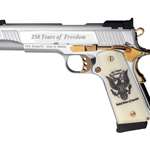
When it comes to self-defense strategies for women, especially those of us who carry concealed, self-defense experts will usually emphasize the importance of maintaining what Col. Jeff Cooper dubbed "Condition Yellow." The definition of Condition Yellow is deceptively simple: It's a state of relaxed alertness. That said, there is a tremendous body of factual, strategic and even philosophical thought that comes packed into that concept. One way to describe it that most of us already understand is to equate it to the way we are taught to drive. (Of course, this metaphor isn't perfect. The biggest difference is that driving is a privilege that must be earned, while self-defense is an inborn right.) Here's how what you already know about the "rules of the road" can translate directly into your personal-defense strategy—especially if that includes carrying a firearm or other defensive tool on your person.
The Thing to Fear is Fear Itself
One of the most common worries that people, especially women, who are considering armed self-defense have is that they will find the experience of carrying a defensive tool stressful. This is because in our culture women are socialized to be gentle and passive, so the idea of wielding potentially lethal force may feel unorthodox. But consider this: If you are like most Americans, every single day you spend an hour or more in sole control of a complex machine that weighs upwards of a ton, is carrying several gallons of highly flammable material in close proximity to open sparks—and is capable of acceleration far in excess of its ability to slow down or stop. Of course, that would be your car. But most of us approach our daily commutes with very little anxiety. This is in part because we're well aware that letting our emotions get the better of us while we're negotiating rush-hour traffic will make things far more annoying and/or dangerous for us than they have to be. It's also because we have developed our skills through frequent repetition until much of what we need to do while behind the wheels of our cars has become virtually automatic.
It's very much the same when one is carrying a gun. The more you practice with your firearm on the range, the more comfortable you will be with its safe operation. The more you carry your gun, the more it will simply become part of your daily routine. Although you will always be aware of its presence, that awareness will become "background noise" to you in the way that the sound of your tires on pavement is background noise. This isn't to say that you should become complacent; far from it. Which leads us to our next point:
The Only Person You Can Rely Upon to be Safe is You
If you've ever taken a defensive driving course, there are several driving behaviors that are enforced repeatedly. For example, you're trained to look in your side and rearview mirrors every few seconds, to see what is developing not just ahead of you, but behind you and to the sides. You are trained to allow plenty of room between yourself and other drivers so that if someone else is forced to unexpectedly swerve or brake, you'll have enough time to react appropriately. You're taught that other drivers can become distracted, suffer a sudden mechanical failure or drive in an overly aggressive and reckless fashion. It's paramount that you guard your own "perimeters," because you can't and shouldn't count on others to do it for you.
The defensive mindset when you're not driving should be exactly the same. You make use of all your senses to gather as much information about what's happening behind and to your sides as possible. You establish and insist on a perimeter of personal space. You keep your skills sharp by getting the training you need and practicing regularly. You keep your own emotions under control, because you cannot always expect the people around you to behave rationally or have your (or their own) best interests in mind. Which brings us to our final point:
Anticipate the Unexpected
When I was first learning to drive, my father's way of conditioning me to be alert to other drivers' behavior was to engage me in a game called "Jerks On the Road." In the bombastic tones of an overcaffeinated sportscaster, he'd do a running commentary about what all the drivers around me were doing.
“Now here's a contender! This guy in the red Taurus knows his lane is disappearing, but is he going to merge? No! Look at him accelerating right up to the traffic cones—ladies and gentlemen, we have a jerk on the roooooad!"
"Here we go, ladies and gentlemen: We have a police officer who has pulled someone over. Will the lady in the white Toyota ahead of us maintain her speed, or will she slow down so she can enjoy the entertainment? The suspense is killing me! Wow, look at this...she's minding her own business! Ladies and gentlemen, it's not a jerk on the rooooad!"
Although I can't necessarily recommend this training technique for every new driver, it worked for me: It made the practice of watching for developing situations interesting and engaging instead of tense and fearful. It's a technique that's actually fairly easy to translate to your public interactions on foot. Rather than entertaining yourself with your smartphone, you entertain yourself by watching and listening to what's happening around you. Why is that man just standing there in front of the shop I'm about to leave? Why am I hearing a conversation coming from the darkened part of the parking lot? Does the route I'm walking force me to enter a narrow chokepoint? It's the personal-protection version of watching for a bunch of flaring brake lights ahead of you; it allows you to anticipate and avoid situations before they happen to you. And that's one of the most effective ways to guard your and your family's safety...on or off the road.















































